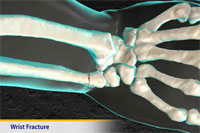
Broken Wrist
What is a broken wrist?
There are 8 bones in the wrist. They attach to the bones in the forearm and the bones in the hand. When your child breaks a wrist, he or she may have broken the ends of the forearm bones (radius or ulna) or one of the 8 wrist bones.
A child's bones are different than adults in some important ways. First, the bones of a child are more flexible. Sometimes the bones crack like green branches from a live tree instead of snapping like a dry stick. Other times the bones just buckle slightly. When this happens, the bone is broken but there isn't a clear fracture line just a slightly raised area on the outside of the bone. The second major difference is that a child's bones are still growing. Bones grow from an area near their ends called the growth plate. Sometimes fractures occur within the growth plate and can be difficult to see on an X-ray. Fractures in this area can affect the growth of the bone and may require special X-rays or other tests.
How does it occur?
The usual causes of a wrist fracture are:
- a fall
- a direct blow to the wrist.
What are the symptoms?
Your child's wrist is painful and swollen. When the navicular bone is fractured, the area below the thumb is tender.
How is it diagnosed?
Your child's healthcare provider will examine the wrist and review the symptoms. An X-ray may show a fracture. Sometimes a fracture may not show up in the first X-ray and your child's provider may recommend that another X-ray is done in 1 to 2 weeks.
How is it treated?
- If the broken bone is crooked, your child's provider will straighten it. Medicine is given to your child first so the straightening is not too painful.
- Your child may be given a splint for their wrist for a few days until the swelling begins to go down. Then the wrist will be put in a cast for 4 to 8 weeks. Certain types of fractures may need to be in a cast longer and may eventually need surgery.
- Your child's healthcare provider may prescribe anti-inflammatory medicines or other pain medicines.
- Elevate the wrist on a pillow or the back of a chair as often as possible for the first 2 to 3 days. This will help control pain and swelling.
- Put ice packs over the cast for 20 to 30 minutes every 3 to 4 hours for the first 2 to 3 days. Most cast material is not made to get wet. If your child needs a cast that can get wet talk to your provider. Your child's provider will determine if the fracture may be safely treated with a waterproof cast.
Don't let your child scratch around or poke things down the cast as this may lead to an infection.
How long will the effects last?
Wrist fractures may take 6 to 12 weeks or longer to heal. Some fractures do not heal and need surgery. Some children may develop stiffness in their wrist. Fractures that go into the growth plate may affect future growth, sometimes resulting in a crooked wrist.
When can my child return to normal activities?
Everyone recovers from an injury at a different rate. Return to normal activities depends on how soon the wrist recovers, not by how many days or weeks it has been since the injury has happened. The goal is for your child to return to normal activities as soon as is safely possible. If your child returns too soon the injury could get worse.
Your child may return to normal activities when they have full range of motion in the wrist without pain. Your child's injured wrist, hand, and forearm need to have the same strength as the uninjured side. If your child returns to using the wrist too soon after a wrist fracture there could be problems with healing. It is very important to be sure that none of your child's activities cause wrist pain or tenderness.
How can a wrist fracture be prevented?
Most wrist fractures are caused by accidents that your child cannot easily prevent. However, your child should wear protective wrist guards during activities such as rollerblading.
When should I call my child's healthcare provider?
Call your child's healthcare provider if:
- The pain is getting worse instead of better.
- Your child has a loss of sensation in the hand or fingers.
- You feel that your child's cast is too tight and they have swelling that doesn't get better when they elevate their injury.

